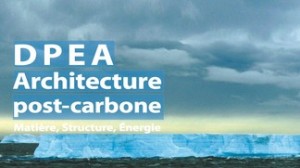Oct 11 2013
The Laboratory of Architecture and Sustainable Technologies (LAST) was invited to take part in the program of the DPEA postgraduate cycle Post-carbon Architecture organized by the "École nationale supérieure d'architecture de la ville et des territoires in Marne-la-Vallée" (EnsaVT) in partnership with the "École des Ponts Paris-Tech".
Based on current research, the lecture presented in this frame by Prof. Emmanuel Rey and Sophie Lufkin, scientific collaborator, was entitled "Symbiotic neighborhoods: issues and opportunities in the perspective of a 2000 Watt society".
 DPEA Post-carbon Architecture
DPEA Post-carbon Architecture
All the present observations and research show that humanity has reached for the first time the point of its history where its influence on the ecosystems is holistic and major. Our ability to precipitate irreversible and abrupt environmental changes raises profound questions about life conditions of our generation and those that follow. The physical and human consequences of that situation impose to reconsider the way we consider the architecture and the city.
The DPEA Post-carbon Architecture, a third cycle diploma of international level is aimed at architects and focuses on three main aspects of the impact of buildings and infrastructure on the environment: materials and their transformation, the architecture of the structure and envelopes, and their energy content. This degree is awarded by the "École nationale supérieure d'architecture de la ville et des territoires in Marne-la-Vallée" (EnsaVT) in partnership with the "École des Ponts Paris-Tech".
This postgraduate training concedes a prospective and exploratory aspect. If it can be considered an innovative training by the approach combining architecture and technical reflection, it is also so through an educational method of the project which articulates two forms of interrogation and implementation of knowledge. It actually articulates the acquisition of analysis and implementation tools for projects and the realization of real case studies.
The lecture of Prof. Emmanuel Rey and Sophie Lufkin was conceived in that specific perspective. Their presentation was an opportunity to mention the first results of the research project "Symbiotic Districts", developed in collaboration with the industrial Ecology Group of the Institute of Land Use Policies and Human Environment (IPTEH) of the University of Lausanne (UNIL) in the frame of the "Collaborative Research on Science and Society" (CROSS) program. This approach is based on the principles of industrial ecology to strengthen synergies and the sharing of resources at the scale of a neighborhood.